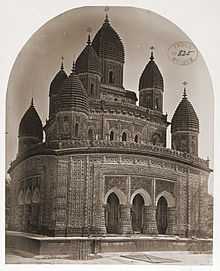Navaratna (architecture)
For other meanings, see Navaratna (disambiguation).

A southern view of Kantajew Temple in Dinajpur, Bangladesh, as it was in 1871, with seven of the nine spires visible, of the navaratna architecture that were subsequently destroyed in an earthquake
The navaratna style of temple architecture (Sanskrit: नवरत्न, meaning "nine gems") incorporates two main levels, each with four spired corner pavilions, and a central pavilion above, for a total of nine spires. The style arose in Bengal during the eighteenth century as an elaboration of the pancharatna style that had five pavilions (four at the corners and one above).[1]
References
- ↑ Ghosh, P. (2005). Temple To Love: Architecture And Devotion In Seventeenth-Century Bengal. Indiana University Press. ISBN 9780253344878.